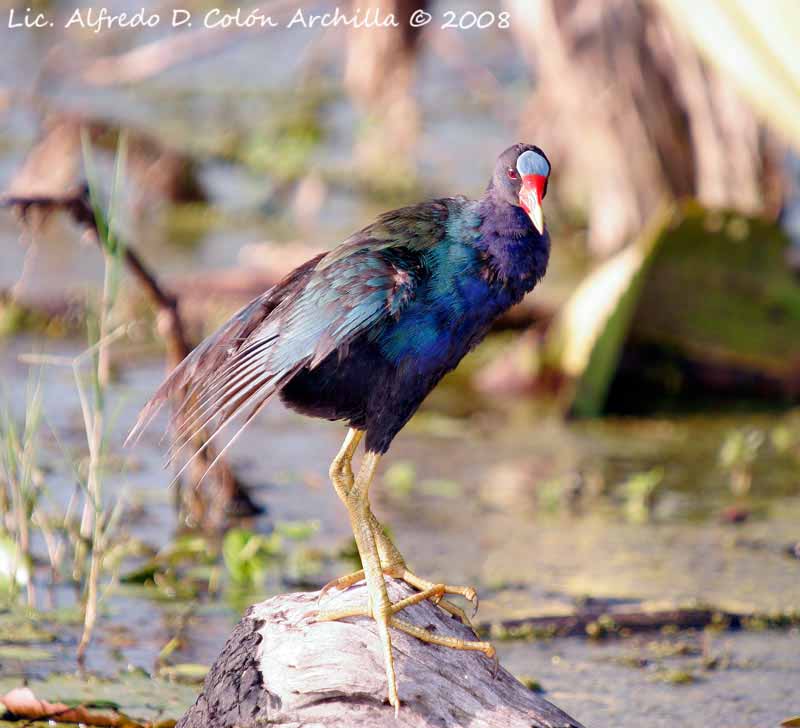
American Purple Gallinule
Porphyrio martinica
Gruiforme Order – Rallidae Family
BIOMETRICS:
Length: 27 à 36 cm
Wingspan: 50-55 cm
Weight: 142-191 g
LONGEVITY: up to 22 years

DESCRIPTION:
Purple Gallinule adult is a medium-sized bird, with stunning purple-blue plumage. Upperparts are glossy green, with upper wings glossy turquoise-blue. Underparts are glossy bluish-violet. White undertail coverts are triangle-shaped and conspicuous in all ages. Vent and thighs are blackish.
Head is purplish-blue, with pale blue forehead shield. Bill is red with yellow tip. Eyes are red. Legs and huge feet are orange-yellow.
Both sexes are similar.
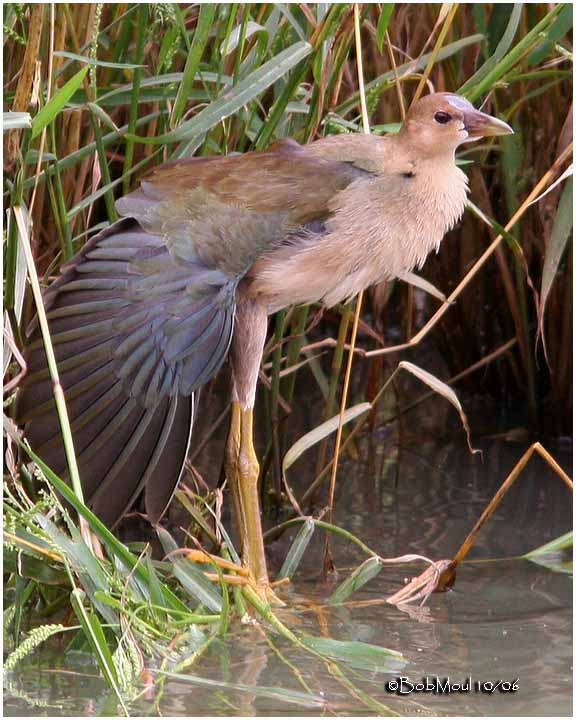
Juvenile is different. It has buff face, neck sides, breast and flanks. Throat and belly are whitish. Crown, hind neck and upperparts are brown, with olive green sheen on body, and greenish turquoise sheen on upper wings. It reaches its adult plumage through first winter, and full adult eye colour, face and neck coloration at about two years. It has brownish eyes. Its bill is duller than adults. Shield is smaller and greyer. Legs and feet are olive-yellow.
Chicks are buffy brown, with brown olive back and greenish wings. Bill is dark olive. Legs and feet are dull olive.
VOICE: SOUNDS BY XENO-CANTO
Purple Gallinule utters varied sharp, shrill calls, a gruff “kruk-kruk-kruk-kruk”, a sharp “kr-lik” or “kee-k”, a wailing call “whiehrrr”, and a rapid, clucking series accelerating then fading when disturbed “keh-keh-keh”. When flying, birds communicate with a cackling “kek-kek-kek”.
HABITAT:
Purple Gallinule lives in swamps, lagoons, ponds and freshwater marshes, with reedbeds and dense floating vegetation, and also in flooded fields. This species needs aquatic vegetation for breeding.
RANGE:
Purple Gallinule breeds in south-eastern United States, from South Carolina and Arkansas, southwards through Caribbean and Central and South America.
It is highly migratory, and it winters from southern Florida to Argentina. South American birds are not usually migratory.
BEHAVIOUR:
Purple Gallinule usually retreats quickly under cover if disturbed. This bird may climb readily into marshy vegetation, and also very high in bushes. It remains close to cover, but we can find it in the open by day.
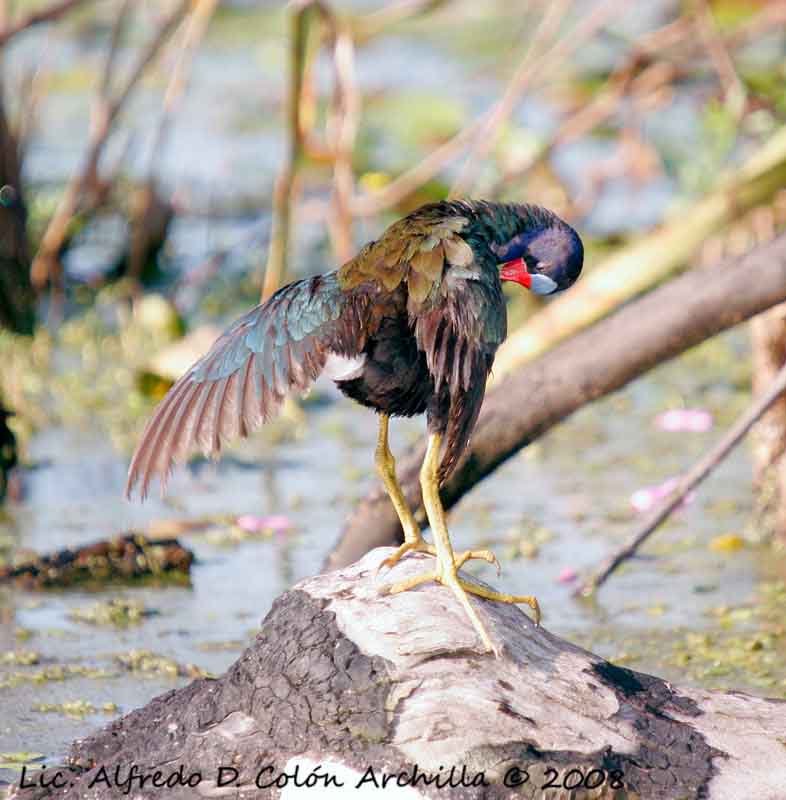
Its large feet with long toes keep the Purple Gallinule on top of the floating vegetation. The bird may walk on wide leaves floating on the surface.
Purple Gallinule walks on floating plants for feeding. It turns over lily pads to find prey underneath. It may swim and dive easily, but it prefers to stay away from open water, to avoid predators such as alligators and turtles. It also climbs in bushes or trees, at about 20 metres above the ground, to find food.
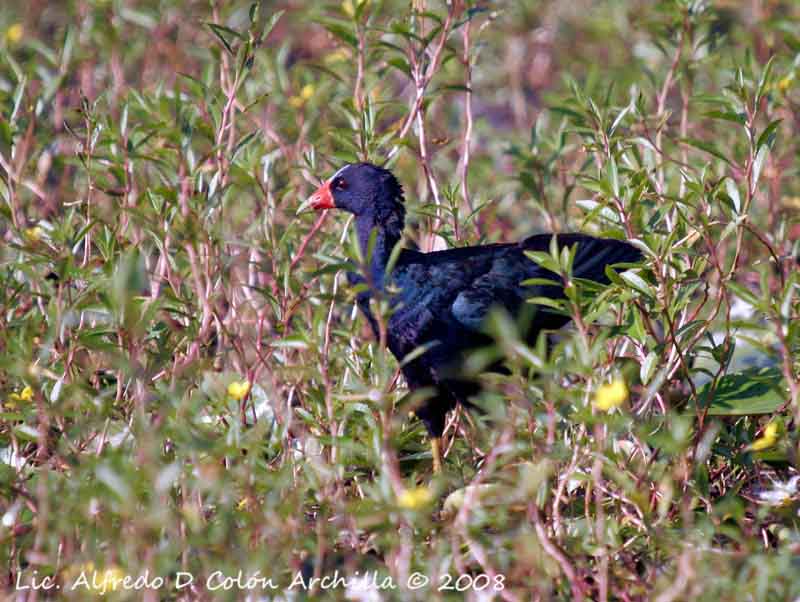
Purple Gallinule breeds in May-August period in North America, but in South America, it may extend from March to November.
Birds are monogamous. During breeding season, the species is highly territorial. They breed in marshy areas, but also in rice fields.
FLIGHT:
Purple Gallinule flies short distances with dangling legs. It flies slowly but direct, with rapid wing beats, but it raises its legs for longer distances.
REPRODUCTION:
Purple Gallinule’s nest is a floating structure. It is a bulky cup-shaped nest in marshy vegetation. Nest is built by both adults, with available floating plants, such as water hyacinth, cattails or wild rice. It may sizes up to 28 cm in width, and about 9 cm in depth. A kind of roof is built for protection, and also a ramp leading to the nest.
Female lays 2 to 6 creamy to pale buff eggs, flecked with rusty brown and grey. Incubation lasts about 18 to 20 days, shared by both adults. Chicks are fed by both parents during one week, and are able to feed themselves after these seven days.
They are completely independent for food at 21 days old. They are able to fly when they are 5 to 7 weeks old. Young use tiny claws on their wing tips to crawl on bushes and out of the nest.
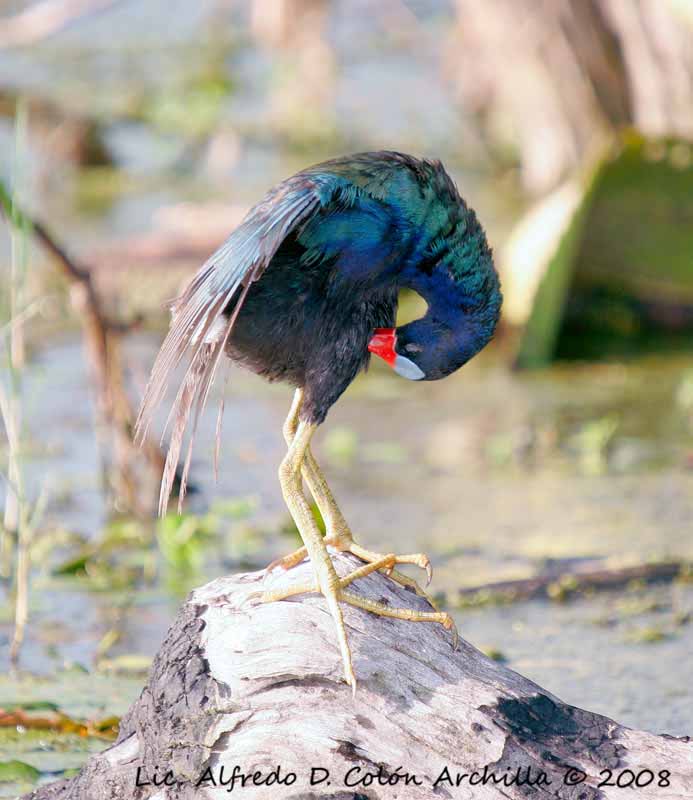
DIET:
Purple Gallinule is omnivorous. It feeds on wide variety of vegetable and animal matters.
It feeds on seeds, leaves and fruits, but it also consumes insects (grasshoppers, beetles, water bugs, bees and wasps), frogs, snails, spiders, earthworms and fish. It may eat the eggs and nestlings of herons and jacanas.
PROTECTION / THREATS / STATUTS:
Purple Gallinule populations are probably decreasing in their range, due to freshwater wetland loss in the United States, and in South and Central America.
Birds have been destroyed in rice fields by aerial spraying with pesticides. They also are preyed upon by alligators and turtles.
However, this species is not considered to be globally threatened.
Fr: Talève violacée
All : Zwergsultanshuhn
Esp : Calamoncillo Americano
Ital : Pollo sultano della Martinica
Nd : Amerikaans Purperhoen
Russe : Пурпурная камышница
Sd : Amerikansk sultanhöna
Photographs by Alfredo Colón
Puerto Rico Wildlife
Photograph of the immature bird by Bob Moul
Nature Photography
Texte de Nicole Bouglouan
Sources :
HANDBOOK OF THE BIRDS OF THE WORLD Volume 3 by Josep del Hoyo-Andrew Elliott-Jordi Sargatal - Lynx Edicions - ISBN : 8487334202
A GUIDE TO THE BIRDS OF COLOMBIA by Steven L. Hilty and William L. Brown
Princeton University Press – ISBN 069108372X
A GUIDE TO THE BIRDS OF MEXICO AND NORTHERN CENTRAL AMERICA by Steve N. G. Howell, Sophie Webb - Oxford University Press - ISBN: 0198540124
Wikipedia (Wikipedia, The Free Encyclopedia)